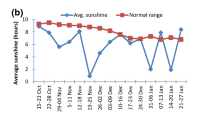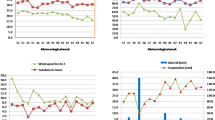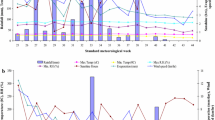Abstract
About half of the total fresh water used for irrigation in Asia is used for rice production. Decreasing water resources and increasing water costs necessitates increasing water use efficiency for rice. The most common method of irrigation in northwestern India is through alternate wetting and drying with a fixed irrigation interval, irrespective of soil type and climatic demand resulting in over-irrigation or under-irrigation under different soil and weather situations. Soil matric potential may be an ideal criterion for irrigation, since variable atmospheric evaporativity, soil texture, cultural practices and water management affect rice irrigation water requirements. A 4-year field study was conducted to assess the feasibility of rice irrigation scheduling on the basis of soil matric potential and to determine the optimum matric potential so as to optimize irrigation water without any adverse effect on the yield. The treatments included scheduling irrigation to rice with tensiometers installed at 15–20 cm soil depth at five levels of soil matric suction viz. 80, 120, 160, 200 and 240±20 cm, in addition to the recommended practice of alternate wetting and drying with an interval of 2 days after complete infiltration of ponded water. The grain yield of rice remained unaffected up to soil moisture suction of 160±20 cm each year. Increasing soil matric suction to 200 and 240±20 cm decreased rice grain yield non-significantly by 0–7% and 2–15%, respectively, over different years compared to the recommended practice of the 2-day interval for scheduling irrigation. Irrigation at 160±20 cm soil matric suction helped save 30–35% irrigation water compared to that used with the 2-day interval irrigation. With a soil matric potential irrigation criterion the total amount of irrigation water used was a function of the number of rainy days and evaporation during the rice season.




Similar content being viewed by others
References
Anbumozhi V, Yamaji E, Tabuchi T (1998) Rice crop and yield as influenced by changes in ponding water depth, water regime and fertigation level. Agric Water Manage 37:241–253
Bhuiyan SI, Sattar MA, Tabbal DF (1994)Wet seeded rice: water use efficiency productivity and constraints to wider adoption. In: Proceedings of international workshop on constraints, opportunities and innovations for wetseeded rice, Bangkok, 31 May 1994–3 June 1994
Borell A, Garside A, Fukai S (1997) Improving efficiency of water for irrigated rice in a semiarid tropical environment. Field Crops Res 52:231–248
Bouman BAM, Tuong TP (2001) Field water management to save water and increase its productivity in irrigated rice. Agric Water Manage 49:11–30
Hira GS (1993) Locally fabricated tensiometers, their problems and use. In: Proceedings, national seminar on developments in soil science. Indian Society of Soil Science, New Delhi, pp 455–456
Hira GS, Singh R, Kukal SS (2002) Soil matric suction: a criterion for scheduling irrigation to rice (Oryza sativa). Ind J Agric Sci 72:236–237
Humphreys E, Thaman S, Prashar A, Gajri PR, Dhillon SS, Yadvinder-Singh, Nayyar A, Timsina J, Bijay-Singh (2004) Productivity, wateruse efficiency and hydrology of wheat on beds and flats in Punjab, India. CSIRO Land and Water Technical Report 03/04
International Rice Research Institute (IRRI) (1997) Rice almanac, 2nd edn. Los Banos, p 181
Kukal SS (2002) Interactive effect of intensity and depth of puddling and water stress on the performance of rice in a sandy loam soil. Ann Agric Res 23:131–135
Kukal SS, Aggarwal GC (2002) Percolation losses of water in relation to puddling intensity and depth in a sandy loam rice (Oryza sativa) field. Agric Water Manage 57:49–59
Kukal SS, Aggarwal GC (2003) Puddling depth and intensity effects in rice- wheat system on a sandy loam soil II Water use and crop performance. Soil Tillage Res 74:37–45
Sandhu BS, Khera KL, Prihar SS, Singh B (1980) Irrigation needs and yield of rice on a sandy loam soil as affected by continuous and intermittent submergence. Ind J Agric Sci 50:492–496
Shock CC, Feibert EBG, Saunders LD (2000) Irrigation criterion for drip irrigated onions. HortScience 35:63–66
Shock CC, Feibert EBG, Seddigh M, Saunders LD (2002) Water requirements and growth of irrigated hybrid poplar in semi-arid environment in Eastern Oregon. West J App Forestry 17:46–53
Sidhu AS, Kukal SS, Singh D, Dwivedi BS (2003) Annual report 2002–2003, National Agricultural Technology Project (ICAR). Department of Soils Punjab Agricultural University, Ludhiana
Steel RGD, Torrie JH (1960) Principles and procedures of statistics. McGraw-Hill, New York, pp 232–251
Timsina J, Connor DJ (2001) Productivity and management of rice-wheat cropping systems: issues and challenges. Field Crops Res 69:93–132
Tripathi RP, Kushawa HS, Mishra PK (1986) Irrigation requirements of rice under shallow water table conditions. Agric Water Manage 12:127–136
Acknowledgements
The authors would like to thank Indian Council of Agricultural Research, New Delhi, for providing funds to carry out this study under National Agricultural Technology Project (PSR mode).
Author information
Authors and Affiliations
Corresponding author
Rights and permissions
About this article
Cite this article
Kukal, S.S., Hira, G.S. & Sidhu, A.S. Soil matric potential-based irrigation scheduling to rice (Oryza sativa). Irrig Sci 23, 153–159 (2005). https://doi.org/10.1007/s00271-005-0103-8
Received:
Accepted:
Published:
Issue Date:
DOI: https://doi.org/10.1007/s00271-005-0103-8




